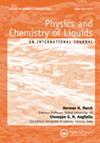从非电解质有机化合物的溶解度数据建立己二酸二甲酯的亚伯拉罕模型相关性
IF 1.1
4区 化学
Q4 CHEMISTRY, PHYSICAL
引用次数: 5
摘要
摘要报道了苊、邻乙酰乙酰苯甲酸、蒽、苯、苯甲酸、苯甲酸、4-叔丁基苯甲酸、1-氯蒽醌、4-氯苯甲酸、2-氯-5-硝基苯甲酸、4-氯-3-硝基苯甲酸、3,4-二氯苯甲酸、3,4-二甲氧基苯甲酸、3,5-二硝基苯甲酸、二苯基砜、2-乙基蒽醌、2-萘氧乙酸、2-羟基苯甲酸、n -羟基邻苯亚胺、2-甲氧基苯甲酸、4-甲氧基苯甲酸、3-甲基苯甲酸、2-甲基-3-硝基苯甲酸、3-甲基-4-硝基苯甲酸、4-甲基-3-硝基苯甲酸、4-硝基苯甲酸、水杨胺、3,4,5-三甲氧基苯甲酸、反式二苯乙烯、硫氧杂蒽-9-酮和杂蒽在298.15 K下溶解于己二酸二甲酯中。这些测量结果,结合已发表的己二酸、戊二酸和琥珀酸的文献数据,用于推导预测的亚伯拉罕模型相关性。推导出的相关性反演了观测到的溶解度数据,误差在±0.12个对数单位内。本文章由计算机程序翻译,如有差异,请以英文原文为准。
Development of Abraham model correlations for dimethyl adipate from measured solubility data of nonelectrolyte organic compounds
ABSTRACT Mole fraction solubilities are reported for acenaphthene, o-acetoacetanisidide, anthracene, benzil, benzoic acid, benzoin, 4-tert-butylbenzoic acid, 1-chloroanthraquinone, 4-chlorobenzoic acid, 2-chloro-5-nitrobenzoic acid, 4-chloro-3-nitrobenzoic acid, 3,4-dichlorobenzoic acid, 3,4-dimethoxybenzoic acid, 3,5-dinitrobenzoic acid, diphenyl sulphone, 2-ethylanthraquinone, 2-naphthoxyacetic acid, 2-hydroxybenzoic acid, N-hydroxyphthalimide, 2-methoxybenzoic acid, 4-methoxybenzoic acid, 3-methylbenzoic acid, 2-methyl-3-nitrobenzoic acid, 3-methyl-4-nitrobenzoic acid, 4-methyl-3-nitrobenzoic acid, 3-nitrobenzoic acid, 4-nitrobenzoic acid, salicylamide, 3,4,5-trimethoxybenzoic acid, trans-stilbene, thioxanthen-9-one and xanthene dissolved in dimethyl adipate at 298.15 K. Results of these measurements, combined with published literature data for adipic acid, glutaric acid and succinic acid, are used to derive predictive Abraham model correlations. The derived correlations back-calculate the observed solubility data to within ±0.12 log units.
求助全文
通过发布文献求助,成功后即可免费获取论文全文。
去求助
来源期刊

Physics and Chemistry of Liquids
化学-物理:凝聚态物理
CiteScore
3.30
自引率
8.30%
发文量
43
审稿时长
6-12 weeks
期刊介绍:
Physics and Chemistry of Liquids publishes experimental and theoretical papers, letters and reviews aimed at furthering the understanding of the liquid state. The coverage embraces the whole spectrum of liquids, from simple monatomic liquids and their mixtures, through charged liquids (e.g. ionic melts, liquid metals and their alloys, ions in aqueous solution, and metal-electrolyte systems) to molecular liquids of all kinds. It also covers quantum fluids and superfluids, such as Fermi and non-Fermi liquids, superconductors, Bose-Einstein condensates, correlated electron or spin assemblies.
By publishing papers on physical aspects of the liquid state as well as those with a mainly chemical focus, Physics and Chemistry of Liquids provides a medium for the publication of interdisciplinary papers on liquids serving its broad international readership of physicists and chemists.
 求助内容:
求助内容: 应助结果提醒方式:
应助结果提醒方式:


